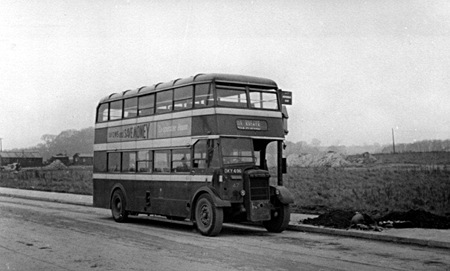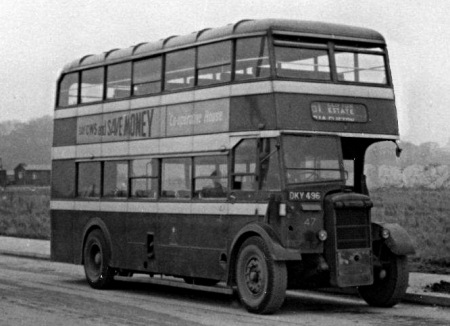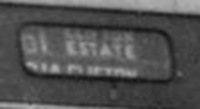
Photographer unknown – if you took this photo please go to the copyright page.
Nottingham City transport
1945
Daimler CWA6
Duple UL27/28R
Some months ago, June 2011 to be precise, there was a question on the Q&As page from Stephen Ford about the ex Bradford lowbridge utilities acquired by Nottingham Corporation Transport for the then new Clifton Estate services.
I have now come across the above photograph of 47 (DKY 496) at a somewhat embryonic Clifton Estate. I have been told that the shot is likely to be Green Lane, Clifton but I can not be certain.
One odd coincidence is that the Daimler utilities were NCT numbered 44-50, the same fleet numbers reappeared on Clifton services a few years later, 44/5 on 1959 Metro Cammell PD2s and 46-50 on 1962/3 Park Royal Daimler Fleetlines. If you are interested you can view Stephens original question at this link.
Photograph and Copy contributed by Bob Gell
29/12/11 – 09:29
Re John Whitakers comment to Stephens original question Pigtroughs and the ‘Flat’ part (roof?) may be understandable, but why the ‘Harriet’ part?
Chris Hebbron
29/12/11 – 14:58
Nice photo of one of my favourite batch of Bradford buses! Many thanks.
I honestly do not know where “Harriets” comes from Chris, but I think it was just a Bradford “rudery”, one of many which former mill workers such as myself tried valiantly to disregard!
John Whitaker
29/12/11 – 17:58
Doncaster had some highbridge Weymann CWA6’s which looked a bit uncurved like this and lasted much longer – ’43 -‘ 58 – and seemed indestructible, if I recall, rather agricultural.
Joe
30/12/11 – 07:27
Bradford had highbridge CWA6s too, Joe, and these lasted until 1958, until replaced by 25 ex London RTs.The lowbridge ones were sold earlier, as there was no need for lowbridge buses in the city. Also sold by 1953 were 467, the solitary lowbridge Arab 1, 474/475, 2 Weymann highbridge Arabs, and 6 Massey bodied CWG5 Daimlers, 468 -473. 467 was retained as a “school bus” , BCPTs term for a driver trainer.
As a schoolboy, I loved the flat Harriets so much because they were so different. I always had a fascination for old and decrepitly scruffy buses as they contrasted so vividly with the “posher” stock.
I defer from going into further detail regarding the meaning of the phrase,except to say it was not graciously received if directed towards young ladies!
I never used the term myself!
John Whitaker
30/12/11 – 07:31
Probably Green Lane, but could be either the junction with Southchurch Drive (in the centre of the estate) – route 61 terminus, or with Farnborough Road on the south eastern perimeter, which, I think, was the original terminus of the 61A (later extended to Glenloch Drive). Unfortunately, it is not quite possible to read the route number on the combined blind. “Clifton Estate” is just about legible, and my impression is that the number is too long for the simple 61, so could be 61A. Clifton was a council estate re-housing occupants from slum-clearance property in the city. Car ownership was low, and a decent bus service was indispensable from day 1. For a year or two the termini of the progressively extended services were building site locations – probably a big help to the construction workers too!
Stephen Ford
30/12/11 – 08:58
As requested a closer view of DKY 496 minus the bus stop

30/12/11 – 11:18
OK – I retract that. From the closer view it is very clearly 61.

Stephen Ford
09/01/12 – 07:11
The picture was taken at the original Farnborough Road terminus. The vehicle having turned round at the Southchurch Drive junction. This stop was the site of the temporary wooden St Francis Church building. The Daimlers were delivered to Nottingham in BCT blue but were repainted before entering service.
Ray Pettit
03/05/12 – 08:04
Bus 47 entered service with NCT in January 1953 (we moved to Clifton on 12th January 1953). I don’t think that this is at the original terminus at the north junction of Farnborough Road with Southchurch Drive as the Wimpey site huts situated at this location are not there (there was housing on the opposite side of the road)and the lie of the land looks wrong. Service 61 was extended along Southchurch Drive to its junction with Rivergreen from 28th June 1953 and further along Southchurch Drive to Ruddington Road (later renamed Green Lane) from 7th March 1954. Service 61A, which is partially visible on the close up of 47’s destination blind, commenced operation from 4th April 1954. Initially the 61A only ran Monday to Friday peaks and on Saturday.
The location of 47 isn’t the 61A terminus at Farnborough Road/Ruddington Road as there was already some housing at this location when the service started and Ruddington Road isn’t visible in the background. Likewise,I’d rule out Southchurch Drive/Ruddington Road as Ruddington Road isn’t visible in the background (construction of what became known as ‘the top shops’ – at least in where we lived in Clifton – didn’t start until 1954/55). I’d go with the location being Southchurch Drive/Rivergreen. The land at the side of 47 was subsequently occupied by the Clifton Methodist Church and the rising ground in the background would also be consistent with this location.
Service 61 started operation on Wednesday 29th October 1952 after a process via the East Midland Traffic Commissioner that started in September 1951. The process was often acrimonious and subject to unsuccessful appeals to the Minister of Transport by all parties when Road Service Licences were granted at a hearing on 24th September 1952 to NCT, WBUDC and South Notts. So this October will see the 60th anniversary of bus services to Clifton Estate starting.
Michael Elliott
24/10/13 – 08:03
The location of your photograph is Southchurch Drive Green Lane Glapton Woods Whitegate Woods are in the background the woods are on a hill and yet with no houses yet built this would stand out.
Dean Smith
06/08/16 – 06:24
I remember crashes and break-downs coming home from school at Attenborough up the Derby Road Hill to the stop before Canning Circus 1954 ’til 1959. What number bus would that be?
Then going to Mundella Grammar School for a year (1960), don’t remember the bus for that- anyone know?
I think it was a No. 45 bus that took me to Margaret Glen Bott School at Woollaton for the next 4 years.
After that, it was Clifton Hall Girl’s Grammar School- anyone know what bus that would be from Western Terrace just in the Park Estate (knocked down now!!! boo hoo) to Clifton !965-67?
I am writing my memories down so I would be glad if you could pass me on to anyone who is interested in those areas at that time.
Thank you very much, I include my e-mail address, just in case I might receive some helpful information. Like how long did the Park Estate use a horse and cart. I set up a petition to save the horse from redundancy. It was in the papers.
Pippa Robins
07/08/16 – 07:03
Hello Pippa, Assuming these were all ordinary service buses and not school specials, this would be the scenario:
1. Attenborough to/from Canning Circus would be by Barton’s (red buses). There were a number of route numbers (and routes). The most usual route taken by the 3, 5, 5B, 10 or 11 was Attenborough Lane, Depot Corner, Beeston Square, Broadgate (or Queens Road), University Boulevard (or Beeston Lane through the University campus), Gregory Street, Church Street, Lenton Boulevard and Derby Road. The 5X went along the Chilwell by-pass and Queens Road, missing Beeston Square, but otherwise as above. The 5, 5B and 5X were usually double deckers, the others always single deckers.
2. Mundella was near Trent Bridge, and would almost certainly have been a 43 trolleybus from the stop at the top of Alfreton Road – they ran about every 3 minutes throughout the day. Down to the Old Market Square, then Wheeler Gate, Albert Street, Lister Gate (now pedestrianised), Carrington Street past the Midland station, and Arkwright Street (also now pedestrianised), terminating at the Embankment, although I think Muskham Street – the last stop before the terminus was slightly nearer to Mundella.
3. Margaret Glen Bott was on Sutton Passeys Crescent, Wollaton Park estate, and a 45 trolleybus from the Canning Circus stop on Derby Road sounds right, although a bit less frequent than the 39 trolleybus from the Canning Circus stop on Ilkeston Road.
4. Finally, Clifton Hall Girls Grammar. There were several services to Clifton estate (61, 61A, 66, 67 and 68) run jointly by Nottingham City Transport (green buses) – via the new Clifton Bridge opened in 1958, or West Bridgford UDC (brown buses) and South Notts (dark blue buses) – via Trent Bridge and Wilford village. These started from Broad Marsh bus station, but all of them turned into the housing estate at Farnborough Road, quite a long way before reaching Clifton Hall. You would get a good half mile closer by using a South Notts bus heading out to Gotham and Loughborough. This started at Huntingdon Street bus station and by passed the estate, continuing straight along Clifton Lane past the bottom of the drive to Clifton Hall. From Canning Circus, you would take a 43 trolleybus, changing either at Broad Marsh for the joint service, or Trent Bridge terminus for the Loughborough bus, or possibly a 39 to the Central Market, King Edward Street, for Huntingdon Street bus station.
For more general memories, you might like to try the www.nottstalgia.com forum.
Stephen Ford
Leave a Reply